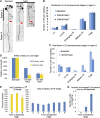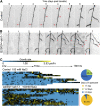Endodermal ABA signaling promotes lateral root quiescence during salt stress in Arabidopsis seedlings
- PMID: 23341337
- PMCID: PMC3584545
- DOI: 10.1105/tpc.112.107227
Endodermal ABA signaling promotes lateral root quiescence during salt stress in Arabidopsis seedlings
Abstract
The endodermal tissue layer is found in the roots of vascular plants and functions as a semipermeable barrier, regulating the transport of solutes from the soil into the vascular stream. As a gateway for solutes, the endodermis may also serve as an important site for sensing and responding to useful or toxic substances in the environment. Here, we show that high salinity, an environmental stress widely impacting agricultural land, regulates growth of the seedling root system through a signaling network operating primarily in the endodermis. We report that salt stress induces an extended quiescent phase in postemergence lateral roots (LRs) whereby the rate of growth is suppressed for several days before recovery begins. Quiescence is correlated with sustained abscisic acid (ABA) response in LRs and is dependent upon genes necessary for ABA biosynthesis, signaling, and transcriptional regulation. We use a tissue-specific strategy to identify the key cell layers where ABA signaling acts to regulate growth. In the endodermis, misexpression of the ABA insensitive1-1 mutant protein, which dominantly inhibits ABA signaling, leads to a substantial recovery in LR growth under salt stress conditions. Gibberellic acid signaling, which antagonizes the ABA pathway, also acts primarily in the endodermis, and we define the crosstalk between these two hormones. Our results identify the endodermis as a gateway with an ABA-dependent guard, which prevents root growth into saline environments.
Figures








Similar articles
-
The Arabidopsis thaliana FASCICLIN LIKE ARABINOGALACTAN PROTEIN 4 gene acts synergistically with abscisic acid signalling to control root growth.Ann Bot. 2014 Oct;114(6):1125-33. doi: 10.1093/aob/mcu010. Epub 2014 Mar 5. Ann Bot. 2014. PMID: 24603604 Free PMC article.
-
Action of natural abscisic acid precursors and catabolites on abscisic acid receptor complexes.Plant Physiol. 2011 Dec;157(4):2108-19. doi: 10.1104/pp.111.182584. Epub 2011 Oct 5. Plant Physiol. 2011. PMID: 21976481 Free PMC article.
-
Arabidopsis drought-induced protein Di19-3 participates in plant response to drought and high salinity stresses.Plant Mol Biol. 2014 Dec;86(6):609-25. doi: 10.1007/s11103-014-0251-4. Epub 2014 Sep 14. Plant Mol Biol. 2014. PMID: 25218132
-
A gateway with a guard: how the endodermis regulates growth through hormone signaling.Plant Sci. 2014 Jan;214:14-9. doi: 10.1016/j.plantsci.2013.09.009. Epub 2013 Sep 26. Plant Sci. 2014. PMID: 24268159 Review.
-
Root layers: complex regulation of developmental patterning.Curr Opin Genet Dev. 2008 Aug;18(4):354-61. doi: 10.1016/j.gde.2008.05.001. Epub 2008 Jul 9. Curr Opin Genet Dev. 2008. PMID: 18617392 Free PMC article. Review.
Cited by
-
Genetic control of root plasticity in response to salt stress in maize.Theor Appl Genet. 2021 May;134(5):1475-1492. doi: 10.1007/s00122-021-03784-4. Epub 2021 Mar 4. Theor Appl Genet. 2021. PMID: 33661350
-
Uncovering natural variation in root system architecture and growth dynamics using a robotics-assisted phenomics platform.Elife. 2022 Sep 1;11:e76968. doi: 10.7554/eLife.76968. Elife. 2022. PMID: 36047575 Free PMC article.
-
Proteomic and metabolomic analyses uncover integrative mechanisms in Sesuvium portulacastrum tolerance to salt stress.Front Plant Sci. 2023 Nov 28;14:1277762. doi: 10.3389/fpls.2023.1277762. eCollection 2023. Front Plant Sci. 2023. PMID: 38089796 Free PMC article.
-
FASCICLIN-LIKE 18 Is a New Player Regulating Root Elongation in Arabidopsis thaliana.Front Plant Sci. 2021 Apr 7;12:645286. doi: 10.3389/fpls.2021.645286. eCollection 2021. Front Plant Sci. 2021. PMID: 33897736 Free PMC article.
-
Allantoin accumulation mediated by allantoinase downregulation and transport by Ureide Permease 5 confers salt stress tolerance to Arabidopsis plants.Plant Mol Biol. 2016 Jul;91(4-5):581-95. doi: 10.1007/s11103-016-0490-7. Epub 2016 May 21. Plant Mol Biol. 2016. PMID: 27209043
References
-
- Abramoff M.D., Magelhaes P.J., Ram S.J. (2004). Image processing with ImageJ. Biophotonics International 11: 36–42
-
- Achard P., Cheng H., De Grauwe L., Decat J., Schoutteten H., Moritz T., Van Der Straeten D., Peng J., Harberd N.P. (2006). Integration of plant responses to environmentally activated phytohormonal signals. Science 311: 91–94 - PubMed
Publication types
MeSH terms
Substances
Grants and funding
LinkOut - more resources
Full Text Sources
Other Literature Sources
Research Materials

